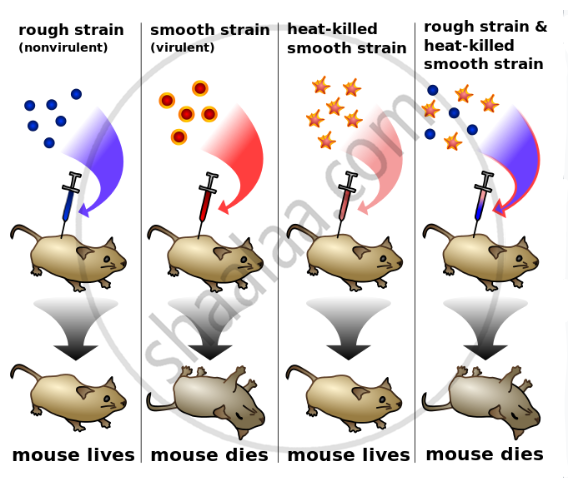Advertisements
Advertisements
प्रश्न
In the light of Griffith’s experiment, explain the action of two stains of Diplococcus pneumoniae and give his conclusion.
उत्तर
Griffith Experiment: The first series of experiments was performed by a British physician, F. Griffith, in 1928, using the bacterium Diplococcus pneumoniae, which causes pneumonia in mammals.
There are two types of strains;
- S-type is capsulated and smooth and
- R-type is non - capsulated and rough.
When S-type of bacteria were injected into healthy mice, the mice developed pneumonia and died. Thus type of bacteria were injected into healthy mice, and the mice developed pneumonia and died. Thus S-type is virulent or pathogenic. When R-type bacteria were injected into healthy mice, they did not cause pneumonia. Thus R-type is avirulent or non-pathogenic.
Conclusion: Griffith concluded that living R-type bacteria must have picked up something from the surrounding medium that contains heat-killed S-type, and got changed to S-type. This change is due to the phenomenon of transformation. He named that something as a transforming principle. It was later proved that this transforming principle is DNA.

APPEARS IN
संबंधित प्रश्न
Transfer of genetic material into a bacterial cell through a viral vector is known as ______.
Explain the Griffith’s experiment in detail with diagram.
Genetic material in HIV is in the form of ____________.
Identify the component common to both DNA and RNA.
What would happen if we inject a mice with the mixture of heat killed S-type and living R-type?
Study the following statements and select the correct option.
- 'R' strain of S. pneumoniae is nonvirulent, rough, non-pathogenic, and non-capsulated.
- 'S' strain of S pneumoniae is virulent, smooth, pathogenic, and encapsulated.
Which one of the following is NOT a genetic material in bacteriophage?
Who proved that DNA is basic genetic material?
Genetic information is carried out by long-chain molecule made up of ______.
Name the scientist who experimentally demonstrated that "DNA is the genetic material."
